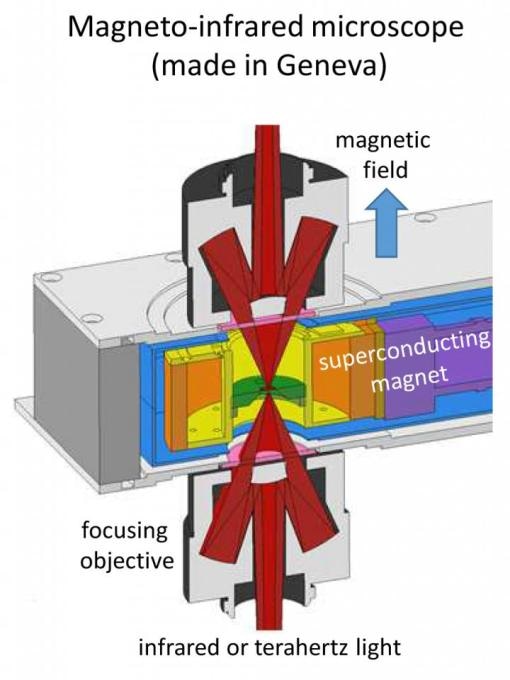Jul 10 2019
The ability to manipulate terahertz and infrared waves using electric or magnetic fields is one of the big challenges in physics that could transform telecommunications, opto-electronics, and medical diagnostics.
 The experimental device that focused infrared and terahertz radiation on small samples of pure graphene in the magnetic field, built by the UNIGE team. (Image credit: ©UNIGE, Ievgeniia Nedoliuk)
The experimental device that focused infrared and terahertz radiation on small samples of pure graphene in the magnetic field, built by the UNIGE team. (Image credit: ©UNIGE, Ievgeniia Nedoliuk)
In 2006, a theory predicted that it could be possible to use graphene—a monoatomic material comprising carbon atoms—in a magnetic field not just to absorb infrared and terahertz light on demand but also to regulate the course of the circular polarization.
Scientists from the University of Geneva (UNIGE), Switzerland, and the University of Manchester have been successful in testing this theory and realized the predicted results. The research, to be published in the journal Nature Nanotechnology, reveals that the researchers discovered an efficient method to manipulate terahertz and infrared waves. It also proved that graphene is true to its primary promises, and is soon to become the material of the future, whether in space or on earth.
"There exist a class of the so-called Dirac materials, where the electrons behave as if they do not have a mass, similar to the light particles, the photons", explains Alexey Kuzmenko, a scientist in the Department of Quantum Matter Physics in UNIGE's Science Faculty, who carried out this research along with Ievgeniia Nedoliuk. One of such materials is graphene, a monolayer of carbon atoms set in a honeycomb structure, analog to graphite used, specifically to manufacture pencils.
The interaction between graphene and light indicates that this material could be employed to manipulate terahertz and infrared waves. "That would be a huge step forward for optoelectronics, security, telecommunications, and medical diagnostics," points out the Geneva-based scientist.
Backing up an old theory via experimentation
A theoretical prediction from 2006 postulated that if a Dirac material, is positioned in a magnetic field, it will create a very powerful cyclotron resonance.
When a charged particle is in the magnetic field, it moves on a circular orbit and absorbs the electromagnetic energy at the orbiting, or cyclotron, frequency, as for example, it happens in the Large Hadron Collider at CERN. And when the particles have charge but no mass, as electrons in graphene, the absorption of light is at its maximum!
Alexey Kuzmenko, Scientist, Department of Quantum Matter Physics, Science Faculty, UNIGE
To show this maximum absorption, the physicists required highly pure graphene, so that the electrons traveling long distances would not scatter on crystal defects or impurities. But this level of purity and lattice order are challenging to get and are only accomplished when graphene is compressed in another 2D material—boron nitride.
The UNIGE scientists partnered with a team from The University of Manchester led by André Geim, who won the 2010 Nobel Prize in Physics for discovering graphene, to develop very pure graphene samples. These samples, which were huge for this type of graphene, were however very small to quantify the cyclotron resonance using the proven methods.
This is why the Geneva scientists came up with a special experimental system to focus the terahertz and infrared radiation on small samples of pure graphene in the magnetic field. "And the result of the experiment confirmed the theory from 2006!" adds Alexey Kuzmenko.
Custom-controlled polarization
The results showed for the first time that a massive magneto-optical effect takes place indeed if a layer of pure graphene is used. "The maximum possible magneto-absorption of the infrared light is now achieved in a monoatomic layer," says Alexey Kuzmenko.
Furthermore, the physicists learned that it was possible to select which circular polarization— right or left—should be absorbed.
Natural or intrinsic graphene is electrically neutral and absorbs all the light, regardless of its polarisation. But if we introduce electrically charged carriers, either positive or negative, we can choose which polarisation is absorbed, and this works both in the infrared and terahertz ranges.
Alexey Kuzmenko, Scientist, Department of Quantum Matter Physics, Science Faculty, UNIGE
This ability has a vital role to play, particularly in the pharmacy, where some important drug molecules interact with light based on polarization direction. Remarkably, this control is said to be promising for the hunt for life on exoplanets, since it is possible to track the signatures of the molecular chirality innate in the biological matter.
Finally, the physicists learned that to monitor a robust effect in the terahertz range, it is adequate to apply magnetic fields, which could be produced by an economical permanent magnet. Since the concept has been established, the scientists will pursue working on magnetically modifiable sources and detectors of infrared and terahertz light. Graphene continues to astonish them.
Source: http://www.unige.ch